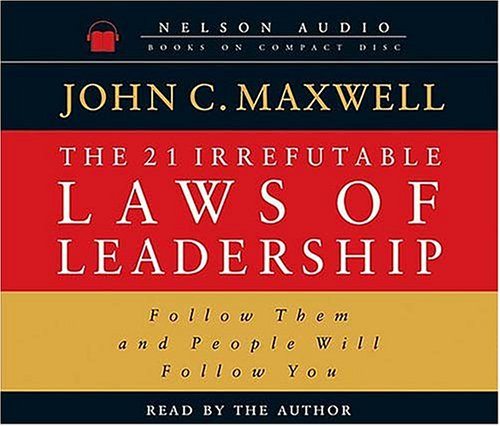- You are here:
- Home »
- Leadership »
- 21 Irrefutable Laws of Leadership
21 Irrefutable Laws of Leadership

The 21 Irrefutable Laws of Leadership by John Maxwell
As leaders, we should all recognize that in order to influence our prospects, customers and fans we need to demonstrate our leadership. Here are some excerpts and observations of the 21 laws, a refresher for most of you but well worth the time to read again. If you haven’t read Maxwell’s book, I would highly recommend it.
1. The Law of the lid.
Your leadership is like a lid or a ceiling on your organization. Your organization or business will not rise beyond the level your leadership allows. That’s why when a corporation or team needs to be fixed, they fire the leader.
2. The Law of Influence.
Leadership is simply about influencing people. Nothing more, nothing less. The true test of a leader is to ask him to create positive change in an organization. If you cannot create change, you cannot lead. Being a leader is not about being first, being an entrepreneur, being the most knowledgeable, or being a manager. Being a leader is not just holding a leadership position. (“It’s not the position that makes a leader, but the leader who makes a position.”) Positional leadership especially does not work in volunteer organizations. The very essence of all power to influence lies in getting the other person to participate. “He who thinks he leads but has no followers is only taking a walk.”
3. The Law of Process.
Leadership is learned over time. And it can be learned. People skills, emotional strength, vision, momentum, and  timing are all areas that can and should be learned. Leaders are always learners.
timing are all areas that can and should be learned. Leaders are always learners.
4. The Law of Navigation.
Anyone can steer the ship, but it takes a leader to chart the course. Vision is defined as the ability to see the whole trip before leaving the dock. A leader will also see obstacles before others do. A leader sees more, sees farther and sees before others. A navigator (leader) listens – he finds out about grassroots-level reactions. Navigators balance optimism with realism. Preparation is the key to good navigation. “It’s not the size of the project, it’s the size of the leader that counts.”
5. The Law of E.F. Hutton.
Hutton was America’s most influential stock market analyst. When he spoke, everyone listened. When real leaders speak, people automatically listen. Conversely, in any group or church, you can identify the real leaders by looking for those to who people listen to. According to Margaret Thatcher, “being in power is like being a lady – if you have to tell people you are, you aren’t.” (p45) Tips for a Positional leader – like a newly appointed minister – who wants to become a REAL leader… look for the existing real leaders and work to have influence there. Factors involved in being accepted as a new real leader include character, building key relationships, information, intuition, experience, and past success. and ability.
6. The Law of Solid Ground.
Trust is the foundation for all effective leadership. When it comes to leadership, there are no shortcuts. Building trust requires competence, connection, and character.
7. The Law of Respect.
People naturally follow people stronger than themselves. Even natural leaders tend to fall in behind those who they sense have a higher “leadership quotient” than themselves.
8 The Law of Intuition.
Leaders evaluate everything with a Leadership bias. Leaders see trends, resources, and problems, and can read people.
9. The Law of Magnetism.
Leaders attract people like themselves. Who you are is who you attract. (Mmmm… I thought like poles were meant to repel!) Handy hint: “Staff” your weaknesses. If you only attract followers, your organization will be weak. Work to attract leaders rather than followers if you want to build a truly strong organization.
10. The Law of Connection.
You must touch the heart before you ask people to follow. Communicate on the level of emotion first to make a personal connection. If you are doing what you are passionate about communicating and connecting is easy!
11. The Law of the Inner Circle.
A leader’s potential is determined by those closest to him. “The leader finds greatness in the group, and helps the members find it in themselves.” (p113) Create a mastermind of trusted advisers and friends.
12. The Law of Empowerment.
Only secure leaders give power to others. Mark Twain said, “Great things can happen when you don’t care who gets the credit.” (p127). Another point to ponder… “Great leaders gain authority by giving it away.”
13. The Law of Reproduction.
It takes a leader to raise up a leader. Followers can’t do it, and neither can institutional programs “It takes one to know one, to show one, to grow one.” The potential of an organization depends on the growth of its leadership.
14. The Law of Buy-In.
People buy into the leader first, then the vision. If they don’t like the leader but like the vision, they get a new leader. If they don’t like the leader or the vision, they get a new leader. If they don’t like the vision but like the leader, they get a new vision.
15. The Law of Victory.
Leaders find a way for the team to win. “You can’t win WITHOUT good athletes, but you CAN lose with them.” p162). Unity of vision, diversity of skills plus a leader are needed for a win.
16. The Law of Momentum.
You can’t steer a ship that isn’t moving forward. It takes a leader to create forward motion.
17. The Law of Priorities.
Activity is not necessarily an accomplishment. We need to learn the difference. “A leader is the one who climbs the tallest tree, surveys the entire situation, and yells “Wrong Jungle!” (p176) If you are a leader, you must learn the three “Rs”… a) what’s Required b) what gives the greatest Return c) what brings the greatest Reward.
18. The Law of Sacrifice.
A leader must give up to go up. Successful leaders must maintain an attitude of sacrifice to turn around an organization. One sacrifice seldom brings success. As he worked to turn around the Chrysler Corporation, Lee Iacocca slashed his own salary to $1 per year.”When you become a leader, you lose the right to think about yourself.”
19. The Law of Timing.
When to lead is as important as what to do and where to go. Only the right action at the right time will bring success.
20. The Law of Explosive Growth.
To add growth, lead followers. To multiply growth, lead leaders. “It is my job to build the people who are going to build the company.”
21. The Law of Legacy.
A leader’s lasting value is measured by succession. “Leadership is the one thing you can’t delegate. You either exercise it – or abdicate it.” We have all heard the saying: “The buck stops here!”
Popular posts
Session expired
Please log in again. The login page will open in a new tab. After logging in you can close it and return to this page.
